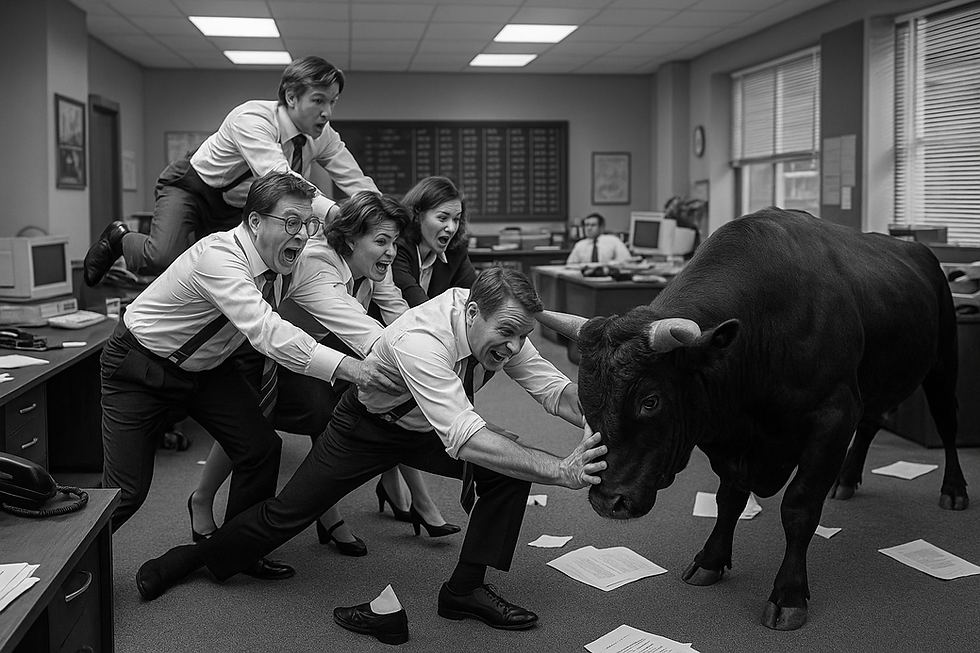STOP-LOSS & TAKE PROFIT: YOUR TRADING SAFETY NET (AND TARGET PRACTICE!)
- Susi Hogan

- Jul 27
- 3 min read
Updated: Nov 16
Trader Terms to Cook Your Noodles – Vol. 5
You’ve met the bulls. You’ve survived the bears.
You understand how to go long, go short, and count your pips like a pro.
Now it’s time to answer two critical questions:
- What stops a bad trade from getting worse?
- And how do you make sure you actually keep your profits?
The answers?
Stop-loss and take profit orders two essential tools that turn chaos into control.
Let’s demystify them.
STOP-LOSS: YOUR FINANCIAL SAFETY NET

Imagine walking a tightrope. You wouldn’t do it without a safety net, would you?
Markets can move fast. A price that looks promising one minute can drop the next.
A stop-loss protects you by setting a pre-agreed exit point before emotions, panic, or second-guessing get in the way.
> A stop-loss is a simple instruction:
> “If the trade goes against me by this much, close it automatically.”
Why it matters:
- It limits your loss to an amount you choose.
- It keeps your account safe without you watching the screen 24/7.
Plain-English Example:
You buy shares at £10, but you decide you don’t want to risk more than £1 per share.
You set your stop-loss at £9. If the price drops that far, the platform closes your trade.
Result: you’ve lost £1 per share not £3, £5, or your nerve.
Key point: A stop-loss isn’t a failure. It’s a plan.
TAKE PROFIT: LOCK IN THE WIN

If stop-loss is defence, take profit is your target.
A take profit is another automated instruction this time to secure your gain when the price hits a level you’re happy with.
> You don’t need to stare at charts.
> You don’t need to guess when to exit.
> You just get the win locked in.
Plain-English Example:
You buy at £10, aiming for £12.
Set your take profit at £12 and the moment price hits it, the trade closes.
That £2 gain is yours, no hesitation required.
No “should I hold?”
No “I’ll just wait for a little more…”
Just profit, banked.
WHY THEY’RE NON-NEGOTIABLE FOR SERIOUS TRADERS
(STOP-LOSS AND TAKE PROFIT)
If you’re trading without stop-losses or take-profits, you’re not trading you’re hoping.
These two tools give you:
- Discipline: Set rules before emotion takes over
- Risk Management: Always know what you stand to lose
- Profit Protection: No more “it was up £300, now I’m in the red…”
It’s not dramatic. It’s deliberate. And it’s how traders stay in the game long enough to succeed.

CLIK’S INSIGHT: MASTERING YOUR TOOLS FROM DAY ONE
At CLiK, we don’t just mention stop-losses and take-profits.
We teach you:
- How to set them based on structure not guesswork
- How to adjust them to suit your trading style
- How to avoid the common traps (like setting stops too tight or targets too vague)
You’ll practise these tools in live sessions. You’ll understand why they matter.
And you’ll feel the difference when your trades run smoother, calmer, and with full control.
UP NEXT: BID-ASK SPREAD — WHY YOU NEVER QUITE GET THE PRICE YOU SAW
So you place a trade at 1.1050… and somehow enter at 1.1052?
In the next blog, we’ll tackle one of the most quietly confusing concepts in all of trading: the bid-ask spread.
It’s a tiny difference but it matters more than you think. And once you understand it, you’ll never look at “market price” the same way again.

Real Traders. Real Support. Real Results.
And we’re just getting started.



Comments